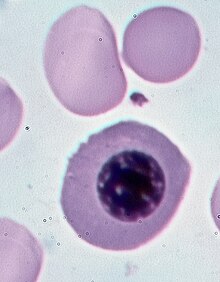Nucleated red blood cell
A nucleated red blood cell (NRBC), also known by several other names, is a red blood cell that contains a cell nucleus. Almost all vertebrate organisms have hemoglobin-containing cells in their blood, and with the exception of mammals, all of these red blood cells are nucleated.[1] In mammals, NRBCs occur in normal development as precursors to mature red blood cells in erythropoiesis, the process by which the body produces red blood cells.
NRBCs are normally found in the
Nomenclature

Several names are used for nucleated RBCs—erythroblast, normoblast, and megaloblast—with one minor variation in word sense.[6][7][8][9] The name normoblast always refers to normal, healthy cells that are the immediate precursors of normal, healthy, mature (anucleate) RBCs. The name megaloblast always refers to abnormally developed precursors. Often the name erythroblast is used
Healthy development
There are four stages in the normal development of a normoblast.:
| Illustration | Description | Image |
 |
Pronormoblast
| |
 |
Basophilic normoblast | 
|
 |
Polychromatic normoblast (also polychromatophilic) | 
|
 |
Orthochromatic normoblast (also orthochromatophilic) | 
|
Pathogenesis
A megaloblast is an unusually large erythroblast that can be associated with
Additional images
-
Blood cell lineage
-
Hematopoiesis
See also
References
- PMID 16824014. Retrieved October 28, 2016.
- ISBN 978-1-4963-6713-6.
- ISBN 978-1-4443-9857-1.
- ^ Shehata, Amira M.F. (2020-09-30). "Clinical significance of nucleated red blood cell count in pediatric patients with transfusion-dependent beta thalassemia". Menoufia Medical Journal. 33 (3): 949–955.
- ^ Blood Smear: Details on RBCs, WBCs
- ^ "Erythroblast" at Dorland's Medical Dictionary
- ^ "Normoblast" at Dorland's Medical Dictionary
- ^ "Megaloblast" at Dorland's Medical Dictionary
- ^ Normoblasts at the U.S. National Library of Medicine Medical Subject Headings (MeSH)
External links
- Pronormoblasts Presented by the University of Virginia
- Basophilic Normoblasts Presented by the University of Virginia
- Polychromatophilic Normoblasts Presented by the University of Virginia
- Orthochromatic Normoblasts Presented by the University of Virginia
- Histology image: 01804loa – Histology Learning System at Boston University - "Bone Marrow and Hemopoiesis bone marrow smear, erythroblast series with proerythroblast "
- Histology at uiowa.edu


